Inhibitory effect of cannabichromene, a major non-psychotropic cannabinoid extracted from Cannabis sativa, on inflammation-induced hypermotility in mice
- PMID: 22300105
- PMCID: PMC3417459
- DOI: 10.1111/j.1476-5381.2012.01879.x
Inhibitory effect of cannabichromene, a major non-psychotropic cannabinoid extracted from Cannabis sativa, on inflammation-induced hypermotility in mice
Abstract
Background and purpose: Cannabichromene (CBC) is a major non-psychotropic phytocannabinoid that inhibits endocannabinoid inactivation and activates the transient receptor potential ankyrin-1 (TRPA1). Both endocannabinoids and TRPA1 may modulate gastrointestinal motility. Here, we investigated the effect of CBC on mouse intestinal motility in physiological and pathological states.
Experimental approach: Inflammation was induced in the mouse small intestine by croton oil. Endocannabinoid (anandamide and 2-arachidonoyl glycerol), palmitoylethanolamide and oleoylethanolamide levels were measured by liquid chromatography-mass spectrometry; TRPA1 and cannabinoid receptors were analysed by quantitative RT-PCR; upper gastrointestinal transit, colonic propulsion and whole gut transit were evaluated in vivo; contractility was evaluated in vitro by stimulating the isolated ileum, in an organ bath, with ACh or electrical field stimulation (EFS).
Key results: Croton oil administration was associated with decreased levels of anandamide (but not 2-arachidonoyl glycerol) and palmitoylethanolamide, up-regulation of TRPA1 and CB₁ receptors and down-regulation of CB₂ receptors. Ex vivo CBC did not change endocannabinoid levels, but it altered the mRNA expression of TRPA1 and cannabinoid receptors. In vivo, CBC did not affect motility in control mice, but normalized croton oil-induced hypermotility. In vitro, CBC reduced preferentially EFS- versus ACh-induced contractions. Both in vitro and in vivo, the inhibitory effect of CBC was not modified by cannabinoid or TRPA1 receptor antagonists.
Conclusion and implications: CBC selectively reduces inflammation-induced hypermotility in vivo in a manner that is not dependent on cannabinoid receptors or TRPA1.
© 2012 The Authors. British Journal of Pharmacology © 2012 The British Pharmacological Society.
Figures




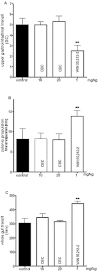


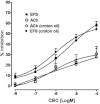
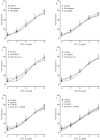
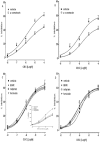
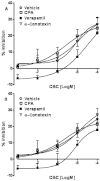
Similar articles
-
Cannabidiol, extracted from Cannabis sativa, selectively inhibits inflammatory hypermotility in mice.Br J Pharmacol. 2008 Jul;154(5):1001-8. doi: 10.1038/bjp.2008.177. Epub 2008 May 12. Br J Pharmacol. 2008. PMID: 18469842 Free PMC article.
-
Effects of cannabinoids and cannabinoid-enriched Cannabis extracts on TRP channels and endocannabinoid metabolic enzymes.Br J Pharmacol. 2011 Aug;163(7):1479-94. doi: 10.1111/j.1476-5381.2010.01166.x. Br J Pharmacol. 2011. PMID: 21175579 Free PMC article.
-
The cannabinoid TRPA1 agonist cannabichromene inhibits nitric oxide production in macrophages and ameliorates murine colitis.Br J Pharmacol. 2013 May;169(1):213-29. doi: 10.1111/bph.12120. Br J Pharmacol. 2013. PMID: 23373571 Free PMC article.
-
The endocannabinoid system.Essays Biochem. 2020 Sep 23;64(3):485-499. doi: 10.1042/EBC20190086. Essays Biochem. 2020. PMID: 32648908 Review.
-
An introduction to the endocannabinoid system: from the early to the latest concepts.Best Pract Res Clin Endocrinol Metab. 2009 Feb;23(1):1-15. doi: 10.1016/j.beem.2008.10.013. Best Pract Res Clin Endocrinol Metab. 2009. PMID: 19285257 Review.
Cited by
-
New insights into pharmacological tools to TR(i)P cancer up.Br J Pharmacol. 2014 May;171(10):2582-92. doi: 10.1111/bph.12561. Br J Pharmacol. 2014. PMID: 24345078 Free PMC article. Review.
-
Individually tailored dosage regimen of full-spectrum Cannabis extracts for autistic core and comorbid symptoms: a real-life report of multi-symptomatic benefits.Front Psychiatry. 2023 Aug 21;14:1210155. doi: 10.3389/fpsyt.2023.1210155. eCollection 2023. Front Psychiatry. 2023. PMID: 37671290 Free PMC article.
-
Transient receptor potential ion channels in primary sensory neurons as targets for novel analgesics.Br J Pharmacol. 2014 May;171(10):2508-27. doi: 10.1111/bph.12532. Br J Pharmacol. 2014. PMID: 24283624 Free PMC article. Review.
-
Novel Synthesis of C-Methylated Phytocannabinoids Bearing Anti-inflammatory Properties.J Med Chem. 2023 Apr 27;66(8):5536-5549. doi: 10.1021/acs.jmedchem.2c01988. Epub 2023 Apr 14. J Med Chem. 2023. PMID: 37057997 Free PMC article.
-
Cannabis sativa: Interdisciplinary Strategies and Avenues for Medical and Commercial Progression Outside of CBD and THC.Biomedicines. 2021 Feb 26;9(3):234. doi: 10.3390/biomedicines9030234. Biomedicines. 2021. PMID: 33652704 Free PMC article. Review.
References
-
- Appendino G, Gibbons S, Giana A, Pagani A, Grassi G, Stavri M, et al. Antibacterial cannabinoids from Cannabis sativa: a structure-activity study. J Nat Prod. 2008;71:1427–1430. - PubMed
-
- Aviello G, Matias I, Capasso R, Petrosino S, Borrelli F, Orlando P, et al. Inhibitory effect of the anorexic compound oleoylethanolamide on gastric emptying in control and overweight mice. J Mol Med. 2008;86:413–422. - PubMed
Publication types
MeSH terms
Substances
LinkOut - more resources
Full Text Sources
Other Literature Sources

